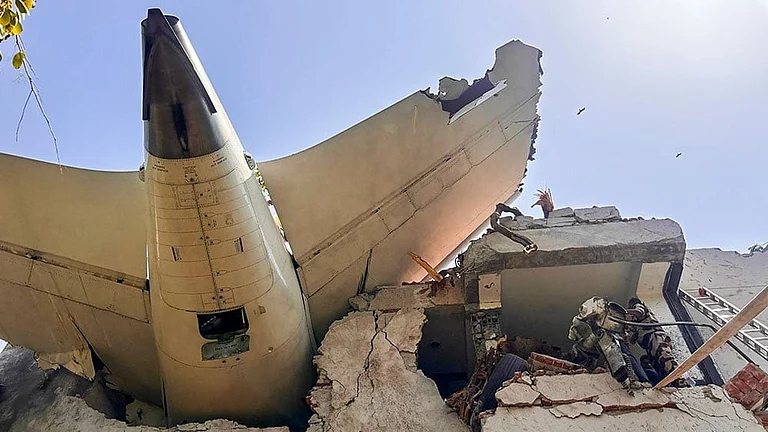Pravin Patel, who drives an auto for a living and lives in one of the slum pockets in Meghaninagar, a densely populated residential area surrounding the international and domestic airports in Ahmedabad, had come home for lunch. As soon as he finished lunch, he heard a loud bang. He thought there was a bomb blast or an earthquake. People rushed out of their homes. Patel and a few others rushed to the spot. A flight had just crashed. It had turned into a ball of fire. Thick black smoke covered the sky.
"The visibility was so low we could not see each other. We could not breathe. Our eyes were watering. Only after a few fire brigade vans arrived and started dousing the fire, we could see the wreckage of the plane. We immediately jumped in to the wreckage as we realised there could be people buried inside. I saw many charred bodies. We tried to do as much as we could until professional help arrived," said Patel.
A few hours after the crash, when fire brigades and ambulances started rushing to the spot, a few citizens took it upon themselves to divert and manage the traffic so that rescue workers can reach the spot as soon as possible.
Close to the crash site, a few volunteers were seen distributing masks as the smoke made breathing extremely difficult. Since it's a densely populated residential area, thousands of curious onlookers had gathered at the spot. A few volunteers helped the official in clearing the area by forming a human chain.

In the next few hours, while charred bodies were being taken out, a few volunteered to carry the bodies on stretchers to the ambulances. A few started arranging for white sheets to wrap the charred bodies in. When the sheets ran out, people living in the slums close by gave their bedsheets and sarees.
By 4 pm, the first batch of fire brigade personnel were completely exhausted. The temperature was 43 degrees, and they had spent hours dousing the fire, wearing layers of clothes and boots. When the second batch arrived, they sat by the compound wall to rest a bit. A few volunteers distributed water, bananas, and biscuits among them.
The sun was about to set. Rescue workers were worried about continuing rescue work at night. A few volunteers started arranging for generators and flashlights.

The flight crashed into a hostel mess and four residential buildings. Prince Patel, the son of Meenaben Pattani, the counsellor of Asrawa area, who was passing by the buildings when the crash happened, immediately jumped into the mess.
"I saw a few students crushed beneath a wall that had collapsed. The building had caught fire. There were suitcases all around. Some people were sitting on chairs, ready to eat lunch. I pulled out a body. They boy was holding a spoon in his hand but he had died," said Patel.
Patel and his friends personally pulled out some bodies.
Baldev Patel, who also drives an auto and rushed to the crash site, also helped in pulling out a few bodies. "There are slums all around. Imagine what would have happened if the flight had crashed into the slums. The casualties would have been much higher. Besides, we rushed to the spot immediately. The persons living in these buildings would not have rushed to the slums to rescue us. That's the irony of any tragedy. Rescue operations depend on who the dead are," he says.

















